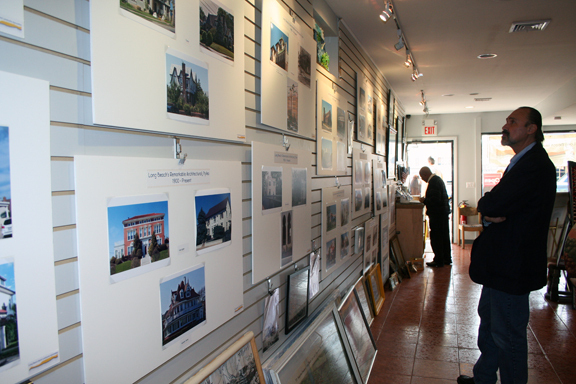Form follows function in Long Beach
Landmarks Association holds architectural exhibit at Evers Place
The week-long exhibit “Architectural Style of Long Beach” was a first of its kind for both the Long Beach Island Landmarks Association and the Evers Place art gallery in the West End. It offered a historical perspective on the city’s development from the 19th century to the present, and featured photos of homes and buildings that illustrate Long Beach’s diverse architectural styles, from neo-classical to Mediterranean to bungalow.
“Long Beach architecture is never pure, it tends to be eclectic,” Franklin Perrell, a former Long Beach resident, said with wine and cheese in hand at the exhibit’s opening reception on Oct. 25. “If it’s art deco, yes, it’s of that style, but it doesn’t look exactly like Radio City Music Hall. Long Beach, because of the presence of the water and intense sun and the flatness topographically, has a tendency to influence the way certain styles are articulated. So whether it’s Georgian or art modern or deco or art revival or Tudor, Long Beach has its own distinct qualities.”
LBILA President Alexandra Karafinas, who organized the exhibit, distinguished the varied styles by placing photos of representative structures on individual display boards. So while one board showed the Spanish colonial revival homes that were the city’s original dwellings in the early 1900s, another marked “Mission,” featured the rectory at St. Mary’s Church on East Park Avenue and the Granada Towers, an apartment building on Riverside Boulevard that is listed on the National Register of Historic Places.
“It’s a beautiful example of Moorish revival,” Karafinas said of the Granada, after she noted the Roman arches at Temple Israel at Riverside Boulevard and the Spanish influence on the Romanesque arches at St. Ignatius Church on West Broadway. Other boards were devoted to Dutch colonials built between Neptune and Monroe Boulevards, bungalows on New York Avenue and a modern, California-style home built last year at the corner of East Walnut Street and Roosevelt Boulevard.

 43.0°,
Partly Cloudy
43.0°,
Partly Cloudy 









